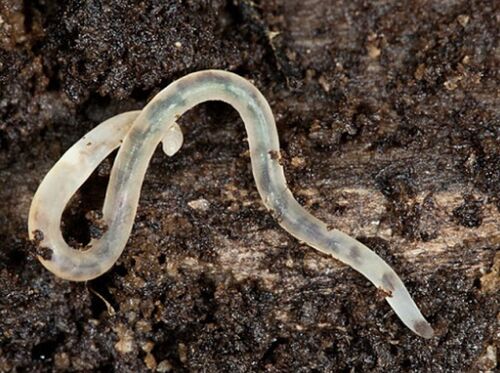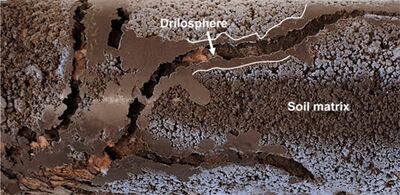Pot Worms: Difference between revisions
| Line 23: | Line 23: | ||
= Ecosystem Impacts = | = Ecosystem Impacts = | ||
Despite their small size, pot worms contribute to the alteration of [[Soil Structures|soil structures]]. They serve to alter soil porosity due to burrowing activities. [1] They also produce worm castings mucus secretions which greatly improve the soil quality by influencing the bacterial and mineral content surrounding their burrows. This areas surrounding their burrows is referred to as the driloshpere. These burrowing and decompositional activities transform decaying materials into humus. [3] Soil humus is the rich, dark, [[Organic Matter|organic matter]] left behind from [[decomposition]]. [4] This organic material allows for more nutrients in the soil structure. Not only do pot worms help to create soil humus but, their burrowing activities play a key roll in mixing the [[Organic Matter|organic matter]] with the existing soil. | Despite their small size, pot worms contribute to the alteration of [[Soil Structures|soil structures]]. They serve to alter soil porosity due to burrowing activities. [1] They also produce worm castings mucus secretions which greatly improve the soil quality by influencing the bacterial and mineral content surrounding their burrows. This areas surrounding their burrows is referred to as the driloshpere. These burrowing and decompositional activities transform decaying materials into humus. [3] Soil humus is the rich, dark, [[Organic Matter|organic matter]] left behind from [[decomposition]]. [4] This organic material allows for more nutrients in the soil structure. Not only do pot worms help to create soil humus but, their burrowing activities play a key roll in mixing the [[Organic Matter|organic matter]] with the existing soil. | ||
[[File: 9F85BCC9-59BE-4987-BE3A-5CC7C057BF3B.jpeg|400px]] | |||
= References = | = References = | ||
Revision as of 15:02, 20 April 2023
Pot worms are a group of normally colorless terrestrial worms in the family enchytraeidae. The family is made up of microdrile oligochaetes living mainly in highly organic terrestrial environments. The term microdrile oligocates refers to their small size in combination with their resemblance to earthworms. Like earthworms, pot worms are in the phylum Annelida.
Taxonomy
| Kingdom | Phylum | Class | Order | Family |
|---|---|---|---|---|
| Animalia | Annelida | Clitellata | Tubificida | Enchitraeidae |
Appearance
Image of a pot worm in soil. [2]
Pot worms, while similar in appearance to earthworms, are slim, colorless, and small. Like earthworms, they are segmented annelids. However, they only grow about 5 to 15 mm in length. [3] While they are visible to the naked eye, they are best seen under a microscope due to their small size. These worms are often referred to as being “white” in color despite them being colorless. This is because they often appear white to the naked eye.
Distribution and Habitat
Diet
Similar to megadrile oligochaetes, earthworms, pot worms consume leafy matter and detritus. However, they gain most of their nutrients from consuming fungal hyphae and bacterial material along with excretions from other soil organisms. [1] This occurs because their smaller size makes it harder for them to consume detritus in the same way as earthworms are able to. Small fungal and bacterial materials are more easily consumed by these small annelids. They consume these decaying materials as they move along channels in the soil. During this process, detritus, plant materials, and organic debris are transformed into soil humus.
Ecosystem Impacts
Despite their small size, pot worms contribute to the alteration of soil structures. They serve to alter soil porosity due to burrowing activities. [1] They also produce worm castings mucus secretions which greatly improve the soil quality by influencing the bacterial and mineral content surrounding their burrows. This areas surrounding their burrows is referred to as the driloshpere. These burrowing and decompositional activities transform decaying materials into humus. [3] Soil humus is the rich, dark, organic matter left behind from decomposition. [4] This organic material allows for more nutrients in the soil structure. Not only do pot worms help to create soil humus but, their burrowing activities play a key roll in mixing the organic matter with the existing soil.
References
Citations
- “All about Enchytraeidae: White Pot Worms.” A Chaos of Delight , https://www.chaosofdelight.org/enchytraeidae-1.
- “5 Different Types of Worms in Potted Plants.” India Gardening , 30 Mar. 2021, https://indiagardening.com/lists/types-of-worms-in-potted-plants/.
- Loynachan, Tom. “Multimedia Gallery | Soil Science Society of America.” Soil Science Society of America , Iowa State University, https://www.soils.org/media-gallery/view/60.
- “Humus.” Education , National Geographic, https://education.nationalgeographic.org/resource/humus/.

